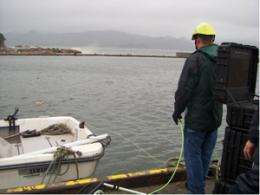Japan, U.S. team deploys underwater robots to coast

A team of research and industry experts with four state-of-the-art small underwater vehicles from the United States-based Center for Robot-Assisted Search and Rescue (CRASAR) are working with the Japanese-based International Rescue Systems Institute (IRS) to inspect damaged bridges, docks, and pipelines, as well as with victim recovery.
The field team is led by professor Tetsuya Kimura (Nagaoka University of Technology) and Texas A&M University computer science and engineering professor Dr. Robin R. Murphy, with funding from the National Science Foundation.
The team initially set up in the devastated city of Minami-sanriku on April 19 and will expand into other areas throughout the week. The suitcase-sized robots have advanced imaging sonars that can penetrate the murky water that often thwarts manual divers. The use of underwater robots for disasters is fairly new and the team hopes the five day deployment will lead to the adoption of marine robots worldwide and to improvements and new research directions.
The remotely operated vehicles, called ROVs, are extremely small versions similar to the robots used at the BP Oil Spill. They vary in size from the suitcase-sized Seamor to the tiny football-sized AC-ROV, making them easy to transport to the ravaged coastline north of Sendai. Three of the robots carry specialized sonars that can see through muddy water and have grippers. The SeaBotix SARbot is designed especially for emergency responders to be able to use to find victims trapped underwater in vehicles. All of the robots have a tether to allow the operators to control the vehicles in real time and see the sonar and video camera footage.
CRASAR and IRS are the leading research centers on rescue robotics, with CRASAR deploying robots to disasters worldwide including the 9/11 World Trade Center and Hurricane Katrina. The US members of the team include Dr. Eric Steimle from AEOS Inc., a Florida start-up company specializing in marine environmental monitoring, Jesse Rodocker and Sean Newsome from SeaBotix, a leading manufacturer of ROVs, and Karen Dreger from the University of South Florida's Center for Ocean Technology. The team members are donating their time and equipment through the CRASAR humanitarian Roboticists Without Borders program.
IRS and CRASAR have held many joint exercises, including one on the day of the earthquake and tsunami at the Disaster City® facilities at Texas A&M. 21 IRS researchers and students had just finished participating in field trials and workshop with CRASAR and were preparing to return to Japan when the quake struck. The IRS members were able to return home and immediately began deploying their ground robots and advising government agencies. They also invited their US colleagues at CRASAR who assembled a team of small, highly portable remotely operated vehicles.
Provided by Texas A&M University


















